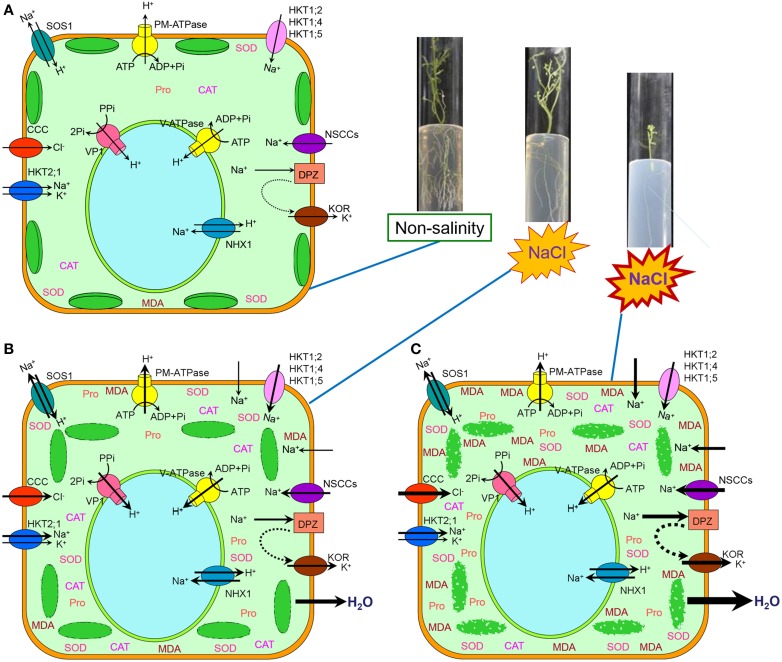Figure 8.
Schematic model of ultrastructural and physiological responding mechanisms of the mesophyll cells from potato (Solanum tuberosum L.) plantlets to gradient saline stress. (A) Under non-salinity condition, water and ions was maintained at a balance status, only little proline (Pro), CAT, SOD, and MDA were accumulated within cytosol, and integrated chloroplasts were closely arranged along plasma membrane. (B) Under moderate salinity condition, abundant Na+ was transported into cytosol probably through non-selective cation channels (NSCCs), high-affinity K+ transporters (HKTs, probably HKT1;2, HKT1;4, HKT1;5, and HKT2;1) and a little permeated directly across plasma membrane, and Cl− was probably transported by cation-Cl− cotransporter (CCC). Some K+ was transported out of the cell by K+ outward-rectifying channels (KORs) activated by membrane depolarization (DPZ). The membrane system was damaged resulting in the increase of MDA and damaged chloroplasts were not closely arranged along plasma membrane. Stoma closed because of water loss and chlorophyll content decreased because of chloroplast damage. For adaptation to moderate salinity, Na+ efflux or extrusion by plasma membrane Na+/H+ antiporter (salt overly sensitive, SOS1) motivated by plasma membrane ATPase (PM-ATPase) and vacuolar Na+ compartmentation by tonoplast Na+/H+ antiporter (NHX1) motivated by vacuolar ATPase (V-ATPase) and H+-pyrophosphatase (VP1) functioned to reduce Na+ toxicity in cytosol, at the same time osmoprotectants such as proline were accumulated and the activities of antioxidant enzymes (CAT and SOD) increased. (C) Under high salinity condition, more and more Na+ was transported into cytosol probably through NSCCs and permeated directly across plasma membrane although the amount of Na+ transported by HKTs did not increase, and more Cl− was probably transported by CCC. More and more K+ was transported out of the cell by KOR. The membrane system was seriously damaged resulting in the rapid increase of MDA and disintegrated chloroplasts appeared. Stoma closed completely because of increasing water loss and chlorophyll content decreased dramatically because of severe chloroplast damage. However, the ability of Na+ efflux or extrusion by SOS1 and vacuolar Na+ compartmentation by NHX1 were not enhanced because of serious damage to membrane system, at the same time osmoprotectant content and the activities of antioxidant enzymes (CAT and SOD) did not increased any more, but even decreased. Therefore, the growth of potato plantlets was inhibited.

